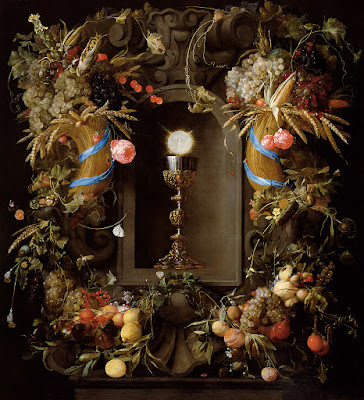 |
| Jan Davidsz de Heem Host and Chalice in Niche with Garland of Fruit and Flowers 1648 oil on canvas Kunsthistorisches Museum, Vienna |
 |
| Jan Davidsz de Heem Vase of Flowers 1670 oil on canvas Mauritshuis, The Hague |
 |
| Jan Davidsz de Heem Flower Still Life with Bowl of Fruit and Oysters ca. 1665 oil on canvas Nationalmuseum, Stockholm |
 |
| Jan Davidsz de Heem Vase of Flowers 1654 oil on canvas Norton Simon Museum, Pasadena |
 |
| Jan Davidsz de Heem Still Life with Flowers in a Glass Vase before 1683 oil on copper Rijksmuseum, Amsterdam |
 |
| Jan Davidsz de Heem Festoon of Fruit and Flowers ca. 1660-70 oil on canvas Rijksmuseum, Amsterdam |
 |
| Jan Davidsz de Heem Swag of Fruit and Flowers ca. 1650-60 oil on canvas Mauritshuis, The Hague |
 |
| Jan Davidsz de Heem Still Life with Lobster on a Stone Ledge ca. 1675 oil on canvas private collection |
 |
| Jan Davidsz de Heem Still Life with Grapes ca. 1660 oil on canvas Hood Museum of Art, Dartmouth College, Hanover, New Hampshire |
 |
| Jan Davidsz de Heem Richly-laid Table with Parrot ca. 1650 oil on canvas Akademie der bildenden Künste, Vienna |
 |
| Jan Davidsz de Heem Still-Life with Parrot and Moor 1641 oil on canvas Musée de la Ville de Bruxelles |
 |
| Jan Davidsz de Heem Still Life 1645 oil on canvas Allen Memorial Art Museum, Oberlin, Ohio |
 |
| Jan Davidsz de Heem Still Life ca. 1650 oil on canvas Cultural Heritage Agency of the Netherlands Art Collection, Rijswijk |
 |
| Jan Davidsz de Heem Still Life with Oysters and Grapes 1653 oil on panel Los Angeles County Museum of Art |
 |
| Jan Davidsz de Heem Still Life with Books 1628 oil on panel Mauritshuis, The Hague |
"Jan Davidsz de Heem was born in Utrecht to a Catholic family. In 1626 he moved to Leiden, where he married his first wife, Aletta van Weede, a native of Utrecht. Nearly a decade later, in 1635, De Heem moved to Antwerp and entered its Saint Luke's Guild. A year after the death of Aletta in 1643, the painter married Anna Ruckers, a native of Antwerp. . . . The few works known from De Heem's first Utrecht period resemble those of the still-life painter Balthasar van der Ast, who may have been his teacher. De Heem painted tonal still lifes with vanitas subjects – books, writing and smoking implements, musical instruments, skulls, and hourglasses. Following De Heem's move to Antwerp, the work of Flemish still-life painter Daniel Seghers provided an important model. De Heem's compositions became more elaborate, and he depicted bouquets and garlands of flowers, baskets of fruit, and various motifs such as glasses, insects, and drapery with great illusionistic veracity."
– from the biographical sketch at the National Gallery of Art, Washington DC